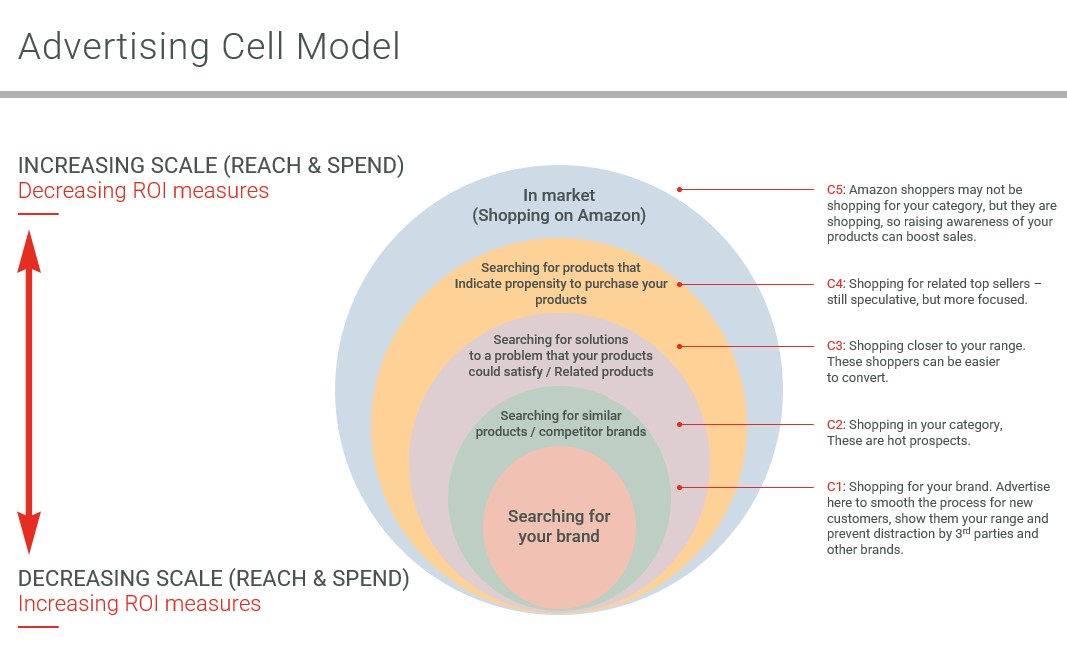One of the joys of Amazon advertising is that it provides a wealth of measurement. You can get metrics at keyword, product, ad group, campaign, portfolio or advertiser level. You can see impressions, clicks, spend, sales and ROAS (Return on Ad Spend) for pretty much anything. In addition, you can view top of search impression share, (but only for Sponsored Products and Sponsored Brands) and new-to-brand orders (but only for Sponsored Brands, Sponsored Display and DSP) and detail page views (but only for Sponsored Brands, Sponsored Display and DSP) and Subscribe and Save subscriptions (but only for DSP). Fairly quickly the different measurements can become confusing rather than insightful. It can be hard to find a consistent set of metrics that really tell you what makes a difference for your business.
The most important thing is to be clear on your objectives.
However, this doesn’t mean you can’t have more than one objective. In fact, most of our clients have at least two:
- To grow the brand by attracting new shoppers
- To defend their brand from competitor ads
Targeting
We try to bring alive the different targeting options through our cell model. This makes clear distinctions between the audiences we target with advertising and feeds into the objective.

If we are creating a defence campaign (targeting Cell 1), we will use keywords that contain the brand name, product targets that are from the same brand (including third party products) or audiences who have previously viewed or purchased the brand. If we are targeting a broader audience then we will be targeting a broader set of keywords/products/audiences. In this case we will exclude the branded terms.
Defending the brand
When measuring the success of these Amazon ads we work with benchmarks that are appropriate for Cell 1 (C1) targeting. These shoppers already have an awareness of the advertised brand so we expect high conversion rates. We accept that some of those shoppers might have gone on to purchase the brand anyway, so we don’t expect high New-to-brand measures (although there is always a degree of NTB) but we will have successfully defended that ad placement against competitors.
To make more productive use of that defensive space, C1 targeting can be used to cross-sell or up-sell. You can also use this targeting to launch new variants and to expand shoppers’ repertoire. In these instances we would expect the sales to be more incremental, but potentially the conversion won’t be as high. However any of these strategies will have the effect of surrounding the shopper with your brand’s presence. This will help to ensure that the shopping journey continues within your brand.
Growing the brand
For these ads we are targeting Cell 2 (C2). We expect lower levels of conversion (or a higher ACoS), but we also expect that more of the ad sales will be incremental with a higher level of New-to-Brand. Some agencies will separate keywords against this objective by creating ads that target generic terms and separate ads that target competitor terms. On the whole, we prefer to lump these together and prioritise within the whole group based on how effective and efficient they are, as all these keywords are relevant against the objective.
Amazon advertising measurement for these two strategies will use different benchmarks and to some extent different measures. We will monitor the efficiency of both sets of campaigns but will have different expectations of what good looks like dependent on objective and market. However the New-to-Brand measure is only really relevant against a growth objective. For accounts that don’t run DSP activity, we can’t measure New-to-brand for Sponsored Product advertising, but in our experience, New-to-brand ratios for Sponsored Brands, Sponsored Products and Sponsored Display are similar, so the SB and SD measures can be used as a proxy.
Additional objectives
When we start to look at objectives beyond the two already mentioned, it’s appropriate to use different measures again. When we are trying to build awareness of a brand and ‘fill the funnel’ with shoppers who might consider it for the first time, we can consider Cell 3 or higher. This would include targeting keywords and products which people might be viewing if they have the same need but a different solution in mind. Or products in adjacent markets. Shoppers looking for a puppy bed might well be in the market for a puppy blanket. Those looking for sleep sprays might be in the market for decaffeinated hot drinks.
When we are looking at this type of targeting (where the conversion may not be immediate), we are looking for Amazon advertising measurement that can be compared with other digital ad platforms and also broadcast media or print, for example. The most appropriate measure is CPM or cost per thousand impressions.
Conclusion
Advertisers need to be able to see how their spend is divided between different objectives, and how effectively they are being achieved. It isn’t helpful for a client to believe that they have efficient Amazon ad campaigns only to find out later that all the budget was spend on a defence strategy. Our recommended practise is to report not only on total metrics, but by objective or cell target.